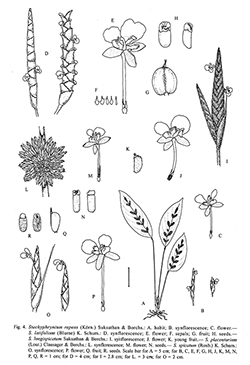e-Flora of Thailand
Volume 9 > Part 2 > Year 2008 > Page 138 > Marantaceae > Stachyphrynium
3. Stachyphrynium placentarium (Lour.) Clausager & Borchs.wfo-0000557825
Kew Bull. 58: 672. 2003.— Phyllodes placentaria Lour., Fl. Cochinch.: 13. 1790.— Phrynium placentarium (Lour.) Merr. in Philipp. J. Sci. 15: 230. 1919; W.Delin & H.Kennedy in Wu & Raven, Fl. China 24: 380. 2000; P.H.Hô, Câyco Viêtnam 3: 465, fig. 9561. 2000. Fig. 4: L–N.
Accepted Name : This is currently accepted.
Synonyms & Citations :
Description : Rhizomatous ground herb, 1–2 m high. Leaves 1–3 per shoot; sheath 35–45 cm long, green, glabrous; petiole 36–71 cm long, green, glabrous to sparsely hairy; pulvinus 2.5–7.5 cm long, dark green, glabrous; lamina ovate-oblong 32–67 by 9.6–22.7 cm, acuminate, green, glabrous to sparsely hairy. Inflorescence interfoliar, erect, sometimes appearing to protrude from the petiole of the accompanying leaf, peduncle 73–110 cm long, green, glabrous to sparsely hairy; synflorescence capitate, 4–8(–10) cm in diam., made up by 6 or more branches of up to several orders, these densely congested, 2.5–3.5 by 1.0–1.5 cm; bracts subtending the proximal branches enlarged, ovate to elliptic, stiff, acuminate, with a sharp spine-tip, 2.1–2.5 by 0.8–2.4 cm, light green with creamy white margin; fertile bracts ovate-elliptic to lanceolate, spirally or distichously arranged, light green with creamy white margin, 2–2.5 by 0.5–1 cm, stiff with a sharp spine-tip; flower-pairs 2–3 per special paraclade, associated prophylls 22–25 by 5 mm, interphylls 22–25 by 8.7 mm. Flowers orange white, ca 2.5–2.7 cm long; sepals 3, free, subequal, linear, ca 2.5–6.2 mm long, white with many purplish-red spots; petal lobes elliptic, acute, ca 6.2 by 2.6 mm, white translucent, deflexed and curled; corolla tube ca 1.7 cm long; staminodal tube ca 6 mm longer than corolla tube; outer staminodes 2, unequal, orange, the larger one broadly obovate, ca 6.5 by 5.2 mm, the smaller one narrower, ca 6.5 by 3 mm; cucullate staminode with unequally lobed margin, pale orange; fertile stamen ca 1 mm long, with a narrow appendage of ca 2.4 by 0.5 mm; style with free part of ca 1.5 mm, hooked; ovary 2 mm long, almost glabrous except for minute hairs in the upper part. Fruits cylindrical, ca 1.2 by 0.5 cm. Seed 1, ca 10.1 by 3 mm, exposed when mature, shining bluish-gray, with a thick, orange or red aril, ca 2 by 3 mm, aril with milky sap.
Thailand : Throughout the country.
Distribution : Widespread in SE Asia (Vietnam – type).
Ecology : Generally forming large colonies next to streams, road sides or disturbed areas, in bamboo forests and lowland evergreen forests, up to 1,200 m alt.
Vernacular : Sat (สาด), sat khao (สาดขาว), ta hep nom (ตาเห็บนม), tong sat (ตองสาด), tong kai (ตองกาย), sat tong khao (สาดตองขาว)(Northern); kelet (เกเล็ด), let (เล็ด)(Peninsular).
Uses: Petioles used to weave mats.
Notes: Stachyphrynium placentarium is easily recognized by its congested-capitate inflorescences and spiny-tipped bracts. Sterile herbarium specimens can often be recognised by a characteristic striate leaf venation.

